HI6006: Competitive Strategy - Strategy Development Tools Essay
VerifiedAdded on 2022/07/28
|10
|2110
|31
Essay
AI Summary
This essay provides a comprehensive overview of competitive strategy and its application in the business world. It delves into three key strategy development tools: PESTLE analysis, Porter's Five Forces analysis, and SWOT analysis. The essay explains each tool's purpose, methodology, and practical applications, emphasizing their importance in helping businesses stay competitive, profitable, and sustainable. PESTLE analysis is presented as a tool for assessing the external environment, including political, economic, social, technological, environmental, and legal factors. Porter's Five Forces analysis is examined as a framework for understanding industry competition and profitability. Finally, SWOT analysis is discussed as a tool for evaluating a company's internal strengths and weaknesses, as well as external opportunities and threats. The essay concludes by highlighting the significance of these tools in formulating long-term business strategies and adapting to changing market conditions. The analysis also includes real-world examples to illustrate how these tools are employed in the business context.
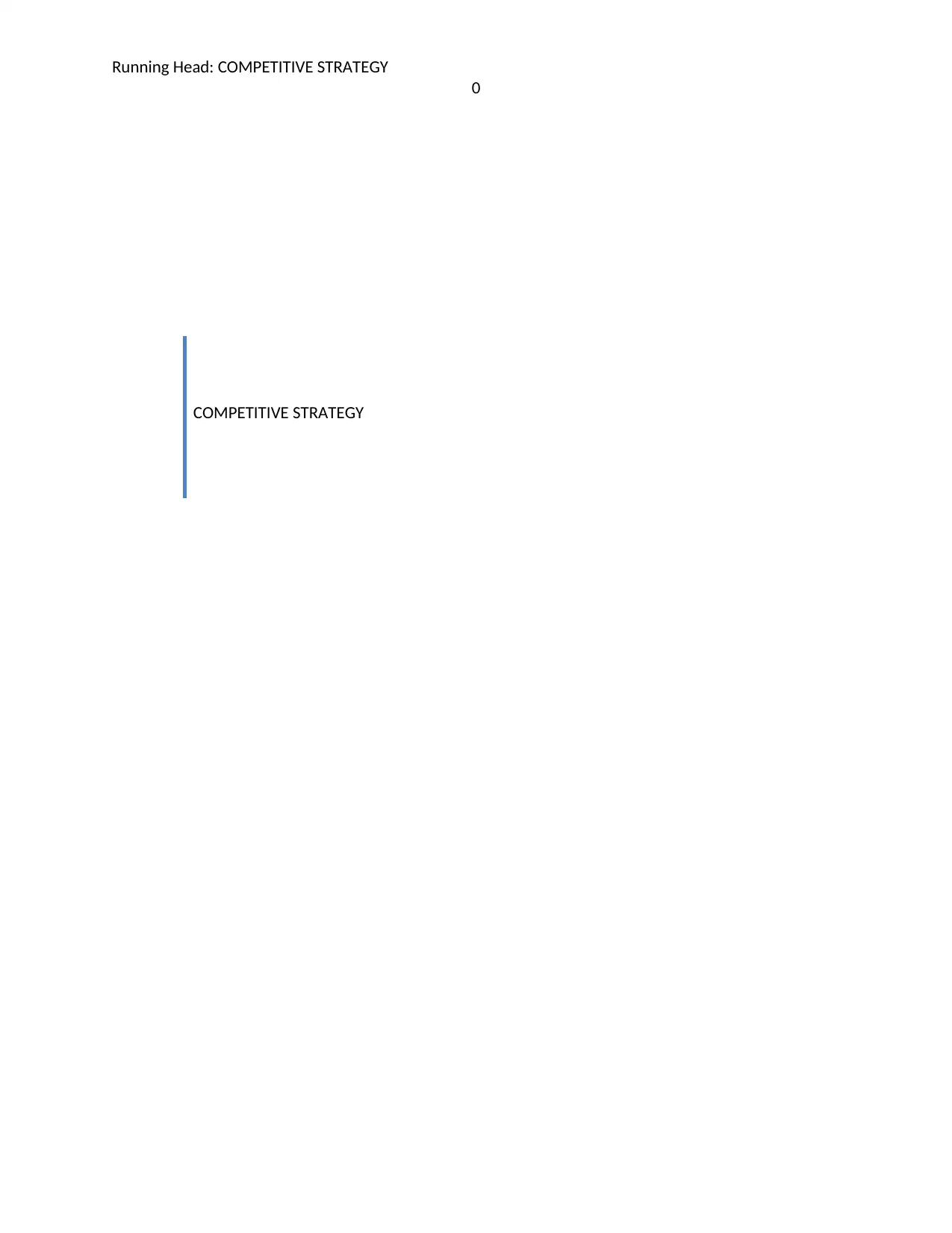
Running Head: COMPETITIVE STRATEGY
0
COMPETITIVE STRATEGY
0
COMPETITIVE STRATEGY
Paraphrase This Document
Need a fresh take? Get an instant paraphrase of this document with our AI Paraphraser
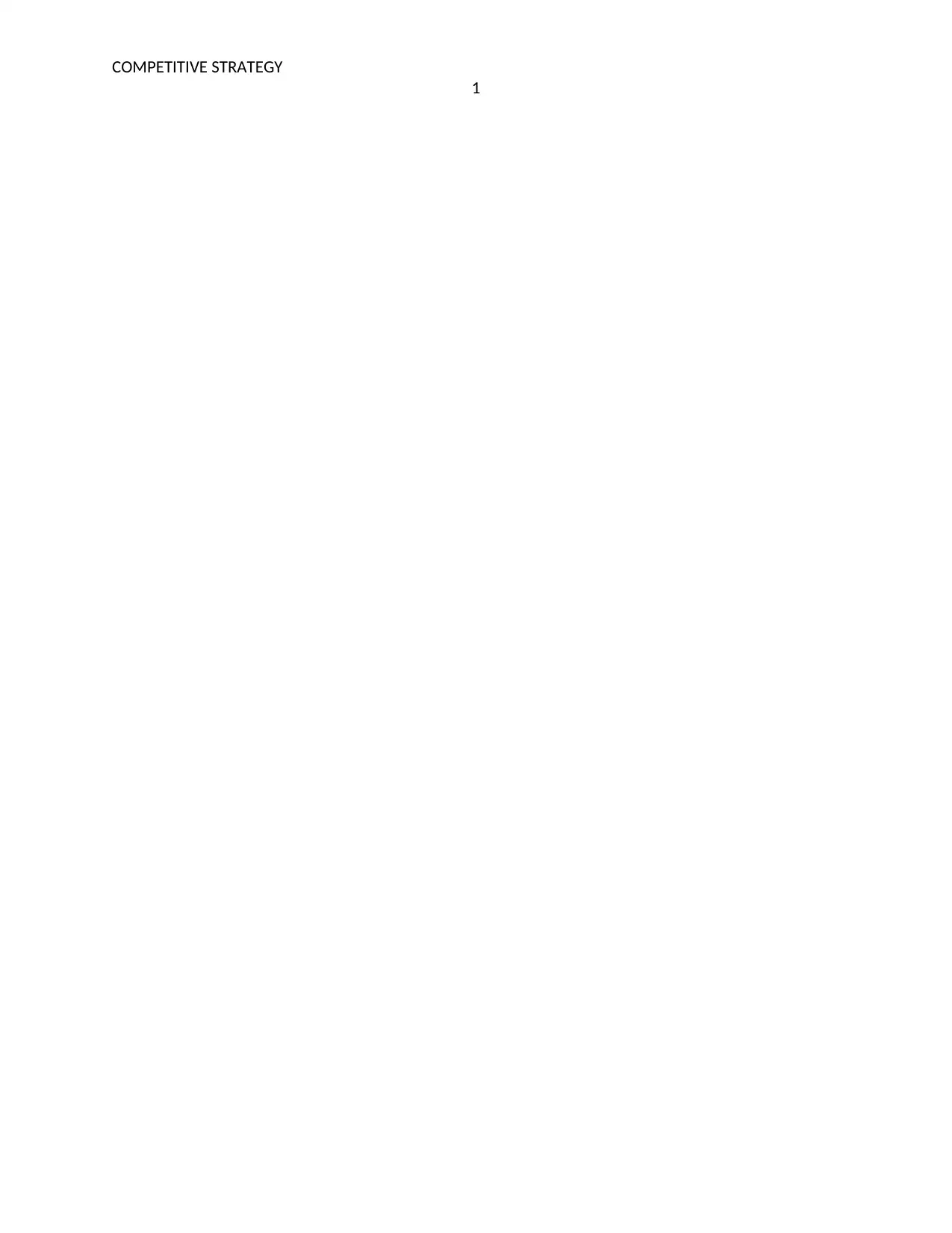
COMPETITIVE STRATEGY
1
1

COMPETITIVE STRATEGY
2
Table of Contents
Introduction......................................................................................................................................2
PESTLE analysis.............................................................................................................................2
Political........................................................................................................................................2
Economic.....................................................................................................................................3
Social............................................................................................................................................3
Technological...............................................................................................................................3
Environmental..............................................................................................................................3
Legal.............................................................................................................................................3
Five forces analysis..........................................................................................................................4
Threats of new entrants................................................................................................................4
Threats of substitute.....................................................................................................................4
Bargaining power of customers...................................................................................................4
Bargaining power of suppliers.....................................................................................................5
Competitive rivalry......................................................................................................................5
SWOT analysis................................................................................................................................5
Strengths.......................................................................................................................................5
Weaknesses..................................................................................................................................6
Opportunities................................................................................................................................6
Threats..........................................................................................................................................6
Conclusion.......................................................................................................................................6
Bibliography....................................................................................................................................7
2
Table of Contents
Introduction......................................................................................................................................2
PESTLE analysis.............................................................................................................................2
Political........................................................................................................................................2
Economic.....................................................................................................................................3
Social............................................................................................................................................3
Technological...............................................................................................................................3
Environmental..............................................................................................................................3
Legal.............................................................................................................................................3
Five forces analysis..........................................................................................................................4
Threats of new entrants................................................................................................................4
Threats of substitute.....................................................................................................................4
Bargaining power of customers...................................................................................................4
Bargaining power of suppliers.....................................................................................................5
Competitive rivalry......................................................................................................................5
SWOT analysis................................................................................................................................5
Strengths.......................................................................................................................................5
Weaknesses..................................................................................................................................6
Opportunities................................................................................................................................6
Threats..........................................................................................................................................6
Conclusion.......................................................................................................................................6
Bibliography....................................................................................................................................7
⊘ This is a preview!⊘
Do you want full access?
Subscribe today to unlock all pages.

Trusted by 1+ million students worldwide
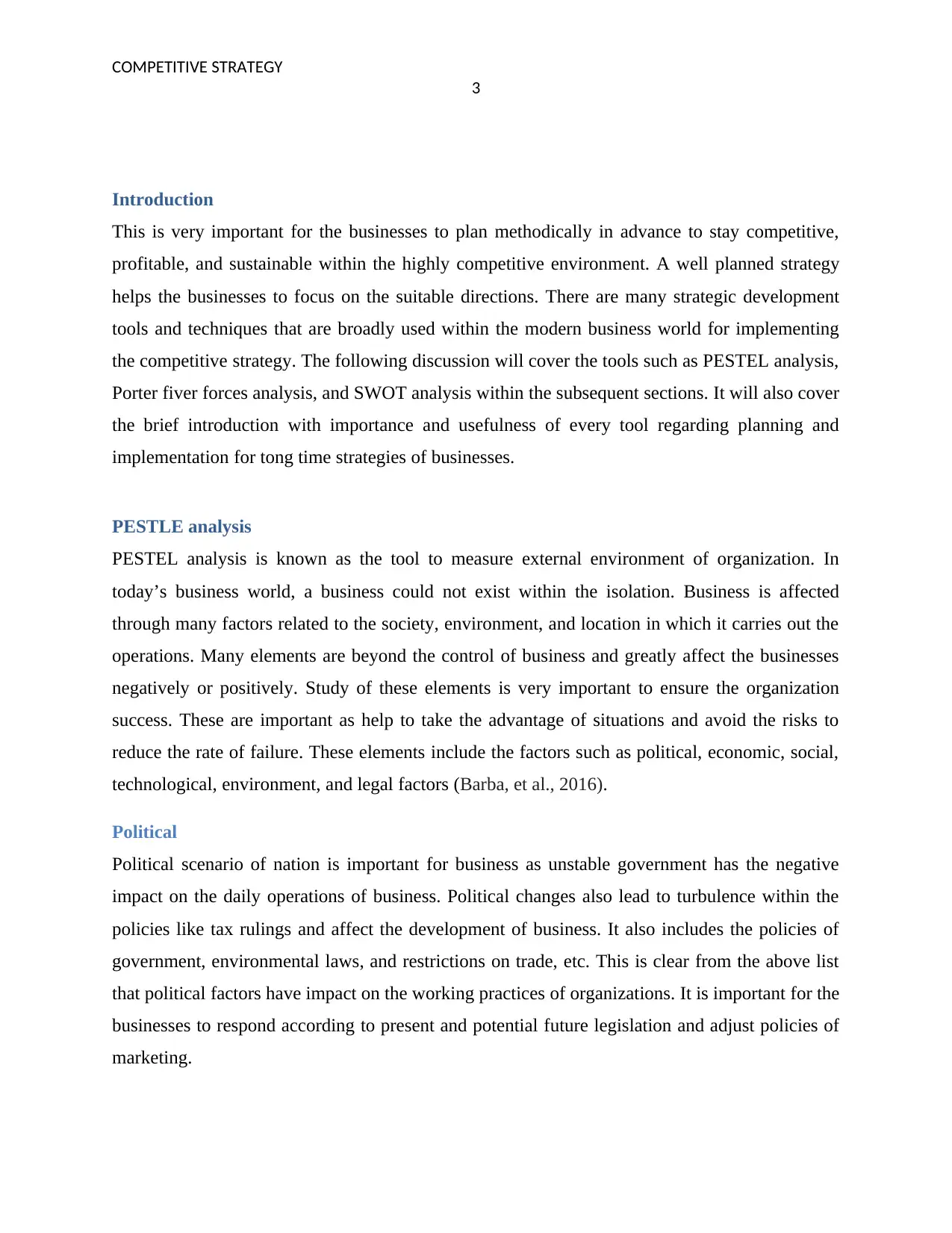
COMPETITIVE STRATEGY
3
Introduction
This is very important for the businesses to plan methodically in advance to stay competitive,
profitable, and sustainable within the highly competitive environment. A well planned strategy
helps the businesses to focus on the suitable directions. There are many strategic development
tools and techniques that are broadly used within the modern business world for implementing
the competitive strategy. The following discussion will cover the tools such as PESTEL analysis,
Porter fiver forces analysis, and SWOT analysis within the subsequent sections. It will also cover
the brief introduction with importance and usefulness of every tool regarding planning and
implementation for tong time strategies of businesses.
PESTLE analysis
PESTEL analysis is known as the tool to measure external environment of organization. In
today’s business world, a business could not exist within the isolation. Business is affected
through many factors related to the society, environment, and location in which it carries out the
operations. Many elements are beyond the control of business and greatly affect the businesses
negatively or positively. Study of these elements is very important to ensure the organization
success. These are important as help to take the advantage of situations and avoid the risks to
reduce the rate of failure. These elements include the factors such as political, economic, social,
technological, environment, and legal factors (Barba, et al., 2016).
Political
Political scenario of nation is important for business as unstable government has the negative
impact on the daily operations of business. Political changes also lead to turbulence within the
policies like tax rulings and affect the development of business. It also includes the policies of
government, environmental laws, and restrictions on trade, etc. This is clear from the above list
that political factors have impact on the working practices of organizations. It is important for the
businesses to respond according to present and potential future legislation and adjust policies of
marketing.
3
Introduction
This is very important for the businesses to plan methodically in advance to stay competitive,
profitable, and sustainable within the highly competitive environment. A well planned strategy
helps the businesses to focus on the suitable directions. There are many strategic development
tools and techniques that are broadly used within the modern business world for implementing
the competitive strategy. The following discussion will cover the tools such as PESTEL analysis,
Porter fiver forces analysis, and SWOT analysis within the subsequent sections. It will also cover
the brief introduction with importance and usefulness of every tool regarding planning and
implementation for tong time strategies of businesses.
PESTLE analysis
PESTEL analysis is known as the tool to measure external environment of organization. In
today’s business world, a business could not exist within the isolation. Business is affected
through many factors related to the society, environment, and location in which it carries out the
operations. Many elements are beyond the control of business and greatly affect the businesses
negatively or positively. Study of these elements is very important to ensure the organization
success. These are important as help to take the advantage of situations and avoid the risks to
reduce the rate of failure. These elements include the factors such as political, economic, social,
technological, environment, and legal factors (Barba, et al., 2016).
Political
Political scenario of nation is important for business as unstable government has the negative
impact on the daily operations of business. Political changes also lead to turbulence within the
policies like tax rulings and affect the development of business. It also includes the policies of
government, environmental laws, and restrictions on trade, etc. This is clear from the above list
that political factors have impact on the working practices of organizations. It is important for the
businesses to respond according to present and potential future legislation and adjust policies of
marketing.
Paraphrase This Document
Need a fresh take? Get an instant paraphrase of this document with our AI Paraphraser
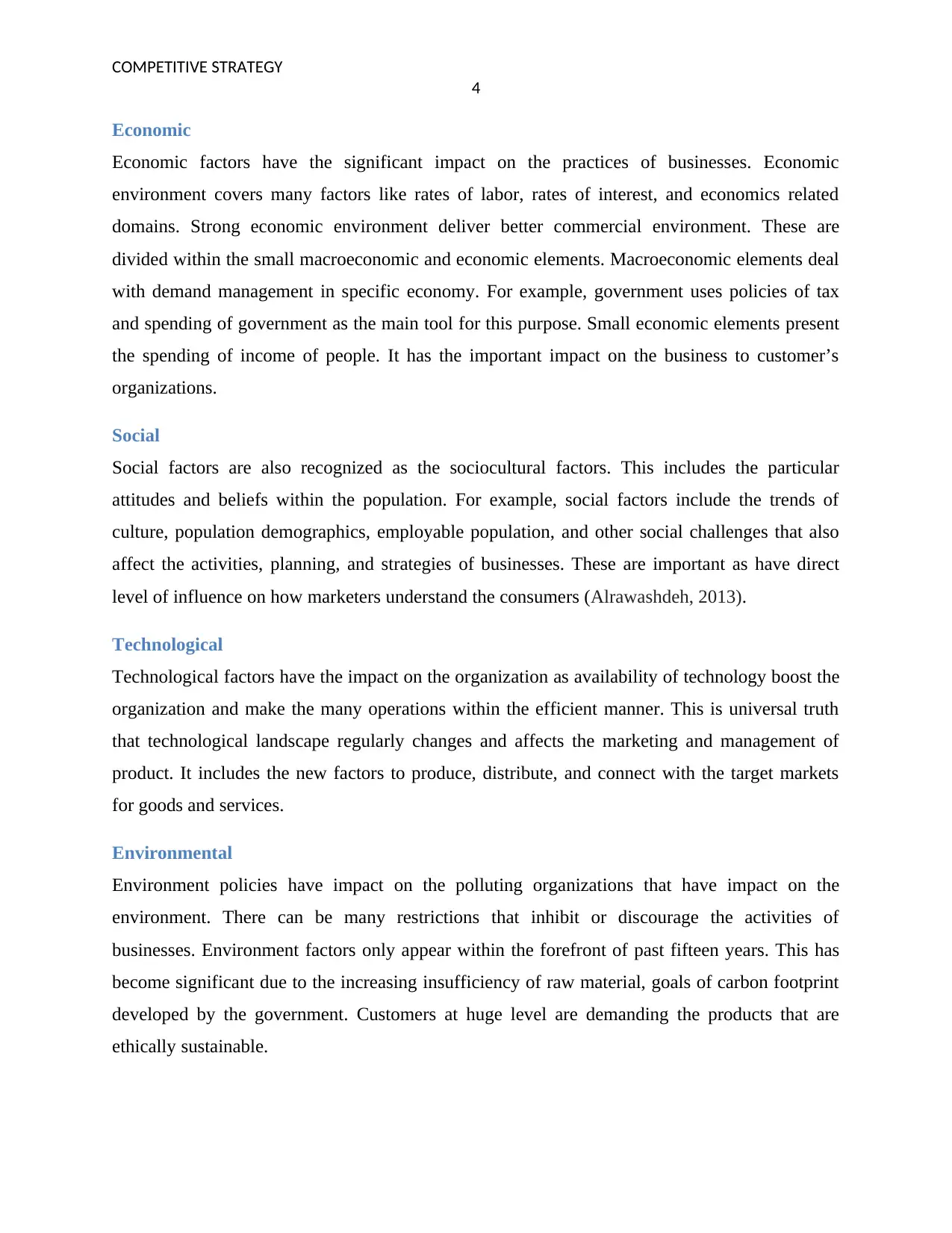
COMPETITIVE STRATEGY
4
Economic
Economic factors have the significant impact on the practices of businesses. Economic
environment covers many factors like rates of labor, rates of interest, and economics related
domains. Strong economic environment deliver better commercial environment. These are
divided within the small macroeconomic and economic elements. Macroeconomic elements deal
with demand management in specific economy. For example, government uses policies of tax
and spending of government as the main tool for this purpose. Small economic elements present
the spending of income of people. It has the important impact on the business to customer’s
organizations.
Social
Social factors are also recognized as the sociocultural factors. This includes the particular
attitudes and beliefs within the population. For example, social factors include the trends of
culture, population demographics, employable population, and other social challenges that also
affect the activities, planning, and strategies of businesses. These are important as have direct
level of influence on how marketers understand the consumers (Alrawashdeh, 2013).
Technological
Technological factors have the impact on the organization as availability of technology boost the
organization and make the many operations within the efficient manner. This is universal truth
that technological landscape regularly changes and affects the marketing and management of
product. It includes the new factors to produce, distribute, and connect with the target markets
for goods and services.
Environmental
Environment policies have impact on the polluting organizations that have impact on the
environment. There can be many restrictions that inhibit or discourage the activities of
businesses. Environment factors only appear within the forefront of past fifteen years. This has
become significant due to the increasing insufficiency of raw material, goals of carbon footprint
developed by the government. Customers at huge level are demanding the products that are
ethically sustainable.
4
Economic
Economic factors have the significant impact on the practices of businesses. Economic
environment covers many factors like rates of labor, rates of interest, and economics related
domains. Strong economic environment deliver better commercial environment. These are
divided within the small macroeconomic and economic elements. Macroeconomic elements deal
with demand management in specific economy. For example, government uses policies of tax
and spending of government as the main tool for this purpose. Small economic elements present
the spending of income of people. It has the important impact on the business to customer’s
organizations.
Social
Social factors are also recognized as the sociocultural factors. This includes the particular
attitudes and beliefs within the population. For example, social factors include the trends of
culture, population demographics, employable population, and other social challenges that also
affect the activities, planning, and strategies of businesses. These are important as have direct
level of influence on how marketers understand the consumers (Alrawashdeh, 2013).
Technological
Technological factors have the impact on the organization as availability of technology boost the
organization and make the many operations within the efficient manner. This is universal truth
that technological landscape regularly changes and affects the marketing and management of
product. It includes the new factors to produce, distribute, and connect with the target markets
for goods and services.
Environmental
Environment policies have impact on the polluting organizations that have impact on the
environment. There can be many restrictions that inhibit or discourage the activities of
businesses. Environment factors only appear within the forefront of past fifteen years. This has
become significant due to the increasing insufficiency of raw material, goals of carbon footprint
developed by the government. Customers at huge level are demanding the products that are
ethically sustainable.
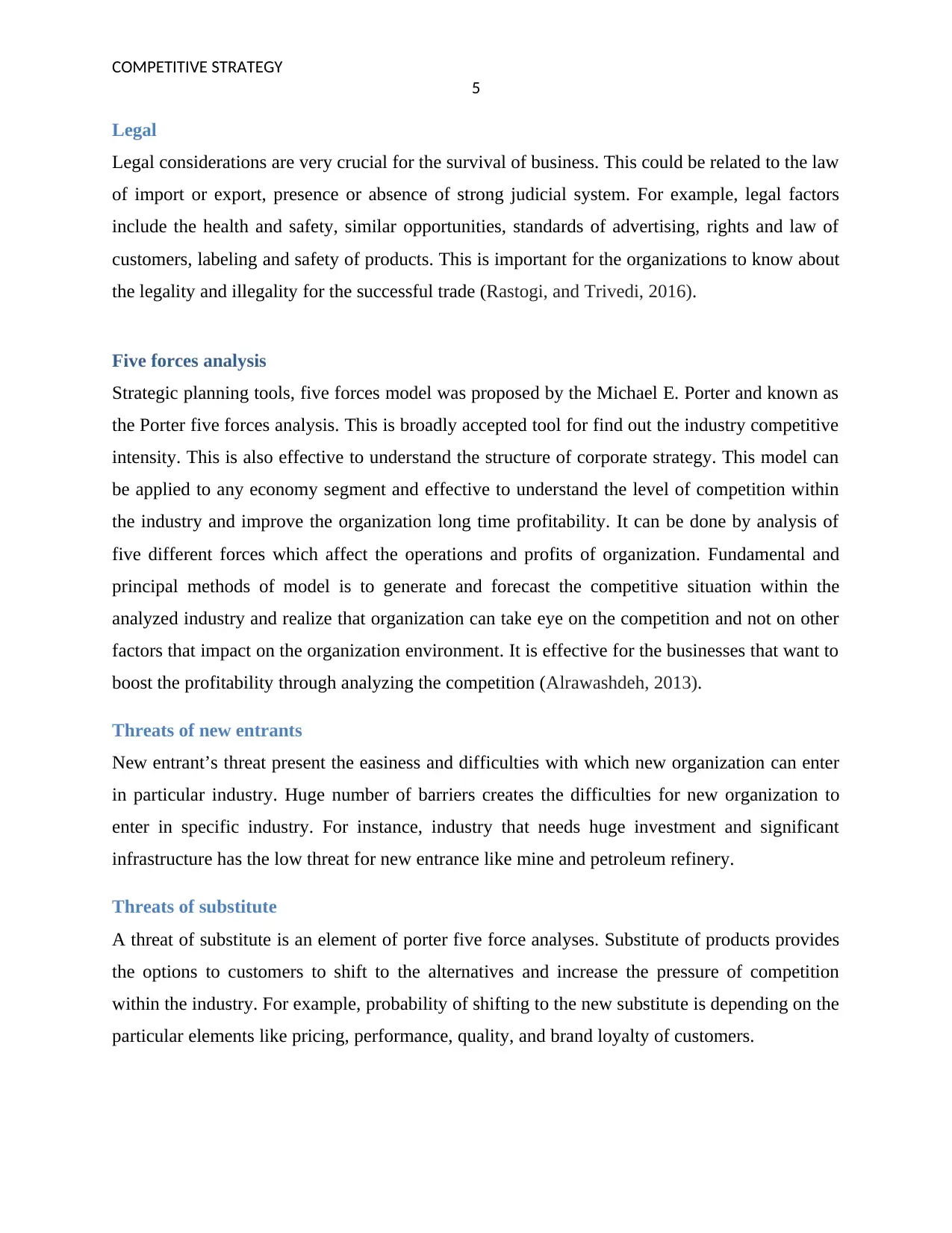
COMPETITIVE STRATEGY
5
Legal
Legal considerations are very crucial for the survival of business. This could be related to the law
of import or export, presence or absence of strong judicial system. For example, legal factors
include the health and safety, similar opportunities, standards of advertising, rights and law of
customers, labeling and safety of products. This is important for the organizations to know about
the legality and illegality for the successful trade (Rastogi, and Trivedi, 2016).
Five forces analysis
Strategic planning tools, five forces model was proposed by the Michael E. Porter and known as
the Porter five forces analysis. This is broadly accepted tool for find out the industry competitive
intensity. This is also effective to understand the structure of corporate strategy. This model can
be applied to any economy segment and effective to understand the level of competition within
the industry and improve the organization long time profitability. It can be done by analysis of
five different forces which affect the operations and profits of organization. Fundamental and
principal methods of model is to generate and forecast the competitive situation within the
analyzed industry and realize that organization can take eye on the competition and not on other
factors that impact on the organization environment. It is effective for the businesses that want to
boost the profitability through analyzing the competition (Alrawashdeh, 2013).
Threats of new entrants
New entrant’s threat present the easiness and difficulties with which new organization can enter
in particular industry. Huge number of barriers creates the difficulties for new organization to
enter in specific industry. For instance, industry that needs huge investment and significant
infrastructure has the low threat for new entrance like mine and petroleum refinery.
Threats of substitute
A threat of substitute is an element of porter five force analyses. Substitute of products provides
the options to customers to shift to the alternatives and increase the pressure of competition
within the industry. For example, probability of shifting to the new substitute is depending on the
particular elements like pricing, performance, quality, and brand loyalty of customers.
5
Legal
Legal considerations are very crucial for the survival of business. This could be related to the law
of import or export, presence or absence of strong judicial system. For example, legal factors
include the health and safety, similar opportunities, standards of advertising, rights and law of
customers, labeling and safety of products. This is important for the organizations to know about
the legality and illegality for the successful trade (Rastogi, and Trivedi, 2016).
Five forces analysis
Strategic planning tools, five forces model was proposed by the Michael E. Porter and known as
the Porter five forces analysis. This is broadly accepted tool for find out the industry competitive
intensity. This is also effective to understand the structure of corporate strategy. This model can
be applied to any economy segment and effective to understand the level of competition within
the industry and improve the organization long time profitability. It can be done by analysis of
five different forces which affect the operations and profits of organization. Fundamental and
principal methods of model is to generate and forecast the competitive situation within the
analyzed industry and realize that organization can take eye on the competition and not on other
factors that impact on the organization environment. It is effective for the businesses that want to
boost the profitability through analyzing the competition (Alrawashdeh, 2013).
Threats of new entrants
New entrant’s threat present the easiness and difficulties with which new organization can enter
in particular industry. Huge number of barriers creates the difficulties for new organization to
enter in specific industry. For instance, industry that needs huge investment and significant
infrastructure has the low threat for new entrance like mine and petroleum refinery.
Threats of substitute
A threat of substitute is an element of porter five force analyses. Substitute of products provides
the options to customers to shift to the alternatives and increase the pressure of competition
within the industry. For example, probability of shifting to the new substitute is depending on the
particular elements like pricing, performance, quality, and brand loyalty of customers.
⊘ This is a preview!⊘
Do you want full access?
Subscribe today to unlock all pages.

Trusted by 1+ million students worldwide

COMPETITIVE STRATEGY
6
Bargaining power of customers
Bargaining power of customers is known as the element of porter five force analyses. While
consumer have the high power to influence the business than it minimizes the industry
attractiveness as have less control over business. Bargaining power of customers is depend on
availability of replacements and easiness of switching (Aithal, 2016).
Bargaining power of suppliers
Bargaining power of suppliers is also an element of porter five forces analysis. While raw
material suppliers have exercise control over the organizations known as input market. Suppliers
exercise more impact on the business as compared to the stakeholders.
Competitive rivalry
Competitive rivalry is final element of porter five forces analysis. The high level of business
rivalry makes the industry less attractive. Measures like price lead to the drastic reduction within
the organization profitability. This could benefit the customers within the short time period but
organizations might not earn profit in long time. It can also lead to the organization closure and
cost benefit to customers will lose within the long time (Hokroh, 2014).
SWOT analysis
SWOT analysis is known as the tools to measure the internal environment of organization. It
stands for strengths, weaknesses, threats, and opportunities. This is powerful tool for the
businesses to gain the success within the competitive environment. This is important for the
organization to manage these factions as help to improve the strengths and opportunities to
leverage on them and plan to overcome from weaknesses and reduce the possible risks in long
time. Strengths and weaknesses are the internal parts of organization. SWOT matrix is effective
to eliminate thread (Gürel, and Tat, 2017).
Main objective of the SWOT analysis is to help the organization to develop the full awareness
about the factors that include within the making of business decisions. In 1960, SWOT analysis
method was created by the Albert Humphrey. This has become one of the important tools for
owners of business to grow and start their activities. This is very typical for the small businesses
to map out the future without evaluating from all angles that include exhaustive look at internal
6
Bargaining power of customers
Bargaining power of customers is known as the element of porter five force analyses. While
consumer have the high power to influence the business than it minimizes the industry
attractiveness as have less control over business. Bargaining power of customers is depend on
availability of replacements and easiness of switching (Aithal, 2016).
Bargaining power of suppliers
Bargaining power of suppliers is also an element of porter five forces analysis. While raw
material suppliers have exercise control over the organizations known as input market. Suppliers
exercise more impact on the business as compared to the stakeholders.
Competitive rivalry
Competitive rivalry is final element of porter five forces analysis. The high level of business
rivalry makes the industry less attractive. Measures like price lead to the drastic reduction within
the organization profitability. This could benefit the customers within the short time period but
organizations might not earn profit in long time. It can also lead to the organization closure and
cost benefit to customers will lose within the long time (Hokroh, 2014).
SWOT analysis
SWOT analysis is known as the tools to measure the internal environment of organization. It
stands for strengths, weaknesses, threats, and opportunities. This is powerful tool for the
businesses to gain the success within the competitive environment. This is important for the
organization to manage these factions as help to improve the strengths and opportunities to
leverage on them and plan to overcome from weaknesses and reduce the possible risks in long
time. Strengths and weaknesses are the internal parts of organization. SWOT matrix is effective
to eliminate thread (Gürel, and Tat, 2017).
Main objective of the SWOT analysis is to help the organization to develop the full awareness
about the factors that include within the making of business decisions. In 1960, SWOT analysis
method was created by the Albert Humphrey. This has become one of the important tools for
owners of business to grow and start their activities. This is very typical for the small businesses
to map out the future without evaluating from all angles that include exhaustive look at internal
Paraphrase This Document
Need a fresh take? Get an instant paraphrase of this document with our AI Paraphraser
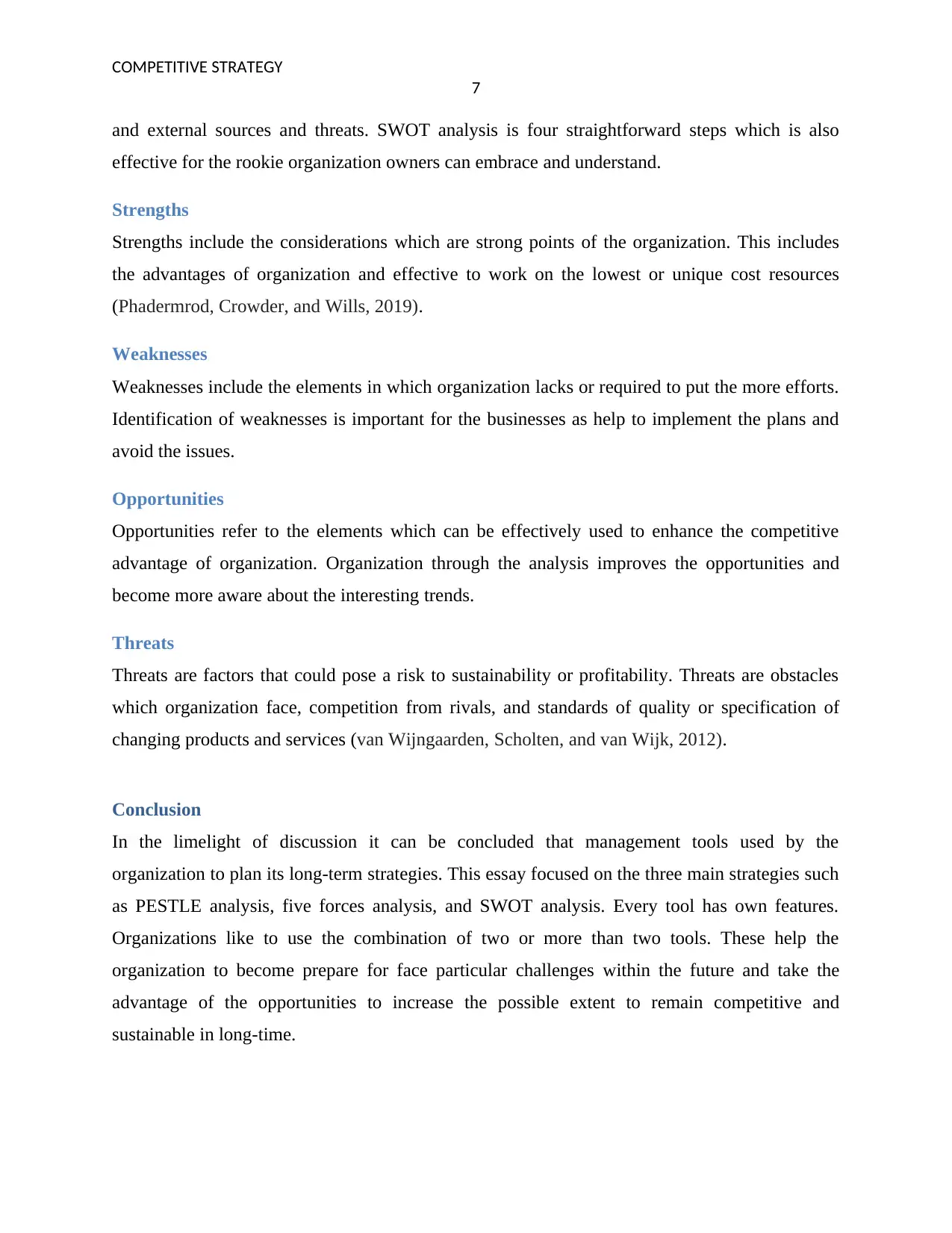
COMPETITIVE STRATEGY
7
and external sources and threats. SWOT analysis is four straightforward steps which is also
effective for the rookie organization owners can embrace and understand.
Strengths
Strengths include the considerations which are strong points of the organization. This includes
the advantages of organization and effective to work on the lowest or unique cost resources
(Phadermrod, Crowder, and Wills, 2019).
Weaknesses
Weaknesses include the elements in which organization lacks or required to put the more efforts.
Identification of weaknesses is important for the businesses as help to implement the plans and
avoid the issues.
Opportunities
Opportunities refer to the elements which can be effectively used to enhance the competitive
advantage of organization. Organization through the analysis improves the opportunities and
become more aware about the interesting trends.
Threats
Threats are factors that could pose a risk to sustainability or profitability. Threats are obstacles
which organization face, competition from rivals, and standards of quality or specification of
changing products and services (van Wijngaarden, Scholten, and van Wijk, 2012).
Conclusion
In the limelight of discussion it can be concluded that management tools used by the
organization to plan its long-term strategies. This essay focused on the three main strategies such
as PESTLE analysis, five forces analysis, and SWOT analysis. Every tool has own features.
Organizations like to use the combination of two or more than two tools. These help the
organization to become prepare for face particular challenges within the future and take the
advantage of the opportunities to increase the possible extent to remain competitive and
sustainable in long-time.
7
and external sources and threats. SWOT analysis is four straightforward steps which is also
effective for the rookie organization owners can embrace and understand.
Strengths
Strengths include the considerations which are strong points of the organization. This includes
the advantages of organization and effective to work on the lowest or unique cost resources
(Phadermrod, Crowder, and Wills, 2019).
Weaknesses
Weaknesses include the elements in which organization lacks or required to put the more efforts.
Identification of weaknesses is important for the businesses as help to implement the plans and
avoid the issues.
Opportunities
Opportunities refer to the elements which can be effectively used to enhance the competitive
advantage of organization. Organization through the analysis improves the opportunities and
become more aware about the interesting trends.
Threats
Threats are factors that could pose a risk to sustainability or profitability. Threats are obstacles
which organization face, competition from rivals, and standards of quality or specification of
changing products and services (van Wijngaarden, Scholten, and van Wijk, 2012).
Conclusion
In the limelight of discussion it can be concluded that management tools used by the
organization to plan its long-term strategies. This essay focused on the three main strategies such
as PESTLE analysis, five forces analysis, and SWOT analysis. Every tool has own features.
Organizations like to use the combination of two or more than two tools. These help the
organization to become prepare for face particular challenges within the future and take the
advantage of the opportunities to increase the possible extent to remain competitive and
sustainable in long-time.
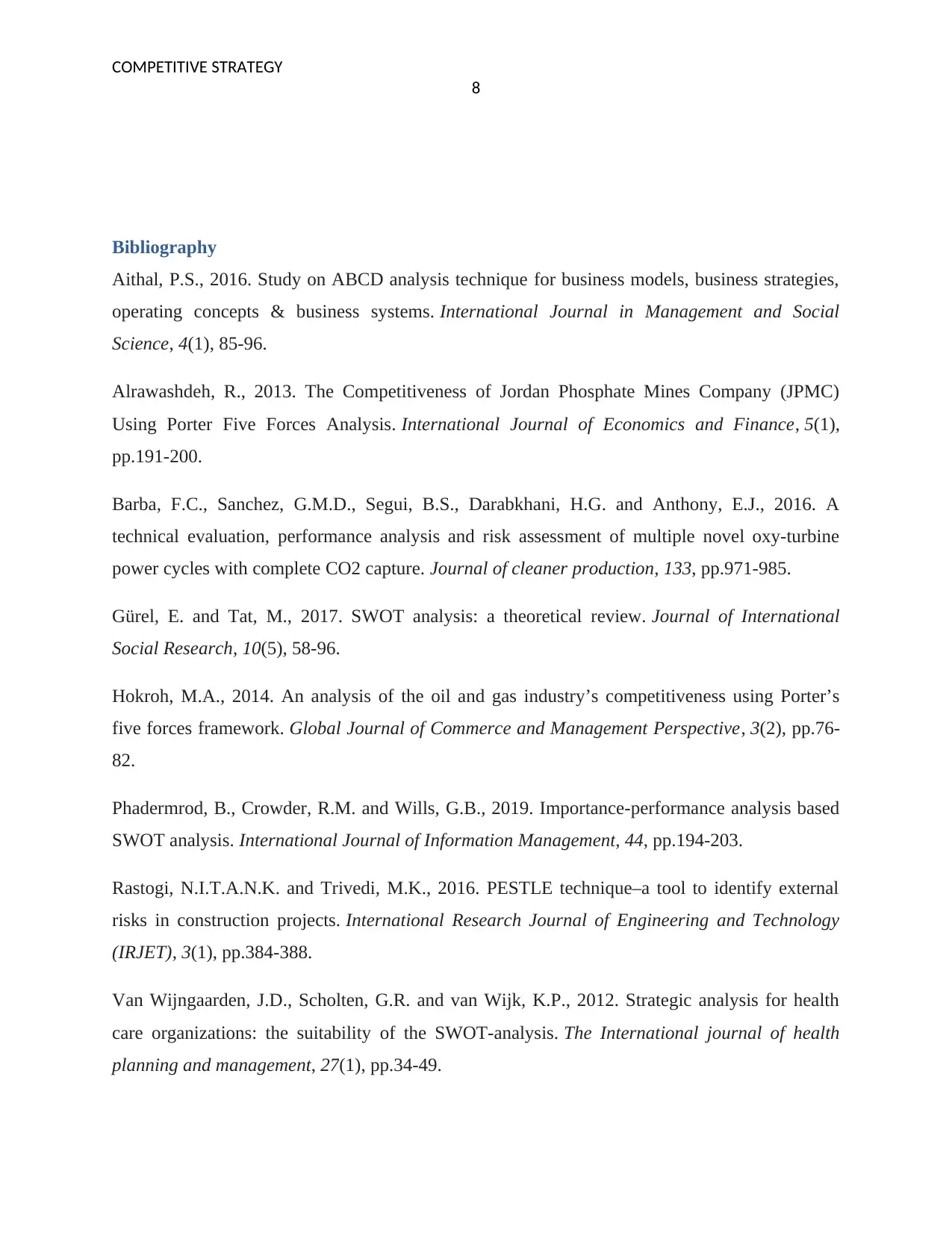
COMPETITIVE STRATEGY
8
Bibliography
Aithal, P.S., 2016. Study on ABCD analysis technique for business models, business strategies,
operating concepts & business systems. International Journal in Management and Social
Science, 4(1), 85-96.
Alrawashdeh, R., 2013. The Competitiveness of Jordan Phosphate Mines Company (JPMC)
Using Porter Five Forces Analysis. International Journal of Economics and Finance, 5(1),
pp.191-200.
Barba, F.C., Sanchez, G.M.D., Segui, B.S., Darabkhani, H.G. and Anthony, E.J., 2016. A
technical evaluation, performance analysis and risk assessment of multiple novel oxy-turbine
power cycles with complete CO2 capture. Journal of cleaner production, 133, pp.971-985.
Gürel, E. and Tat, M., 2017. SWOT analysis: a theoretical review. Journal of International
Social Research, 10(5), 58-96.
Hokroh, M.A., 2014. An analysis of the oil and gas industry’s competitiveness using Porter’s
five forces framework. Global Journal of Commerce and Management Perspective, 3(2), pp.76-
82.
Phadermrod, B., Crowder, R.M. and Wills, G.B., 2019. Importance-performance analysis based
SWOT analysis. International Journal of Information Management, 44, pp.194-203.
Rastogi, N.I.T.A.N.K. and Trivedi, M.K., 2016. PESTLE technique–a tool to identify external
risks in construction projects. International Research Journal of Engineering and Technology
(IRJET), 3(1), pp.384-388.
Van Wijngaarden, J.D., Scholten, G.R. and van Wijk, K.P., 2012. Strategic analysis for health
care organizations: the suitability of the SWOT‐analysis. The International journal of health
planning and management, 27(1), pp.34-49.
8
Bibliography
Aithal, P.S., 2016. Study on ABCD analysis technique for business models, business strategies,
operating concepts & business systems. International Journal in Management and Social
Science, 4(1), 85-96.
Alrawashdeh, R., 2013. The Competitiveness of Jordan Phosphate Mines Company (JPMC)
Using Porter Five Forces Analysis. International Journal of Economics and Finance, 5(1),
pp.191-200.
Barba, F.C., Sanchez, G.M.D., Segui, B.S., Darabkhani, H.G. and Anthony, E.J., 2016. A
technical evaluation, performance analysis and risk assessment of multiple novel oxy-turbine
power cycles with complete CO2 capture. Journal of cleaner production, 133, pp.971-985.
Gürel, E. and Tat, M., 2017. SWOT analysis: a theoretical review. Journal of International
Social Research, 10(5), 58-96.
Hokroh, M.A., 2014. An analysis of the oil and gas industry’s competitiveness using Porter’s
five forces framework. Global Journal of Commerce and Management Perspective, 3(2), pp.76-
82.
Phadermrod, B., Crowder, R.M. and Wills, G.B., 2019. Importance-performance analysis based
SWOT analysis. International Journal of Information Management, 44, pp.194-203.
Rastogi, N.I.T.A.N.K. and Trivedi, M.K., 2016. PESTLE technique–a tool to identify external
risks in construction projects. International Research Journal of Engineering and Technology
(IRJET), 3(1), pp.384-388.
Van Wijngaarden, J.D., Scholten, G.R. and van Wijk, K.P., 2012. Strategic analysis for health
care organizations: the suitability of the SWOT‐analysis. The International journal of health
planning and management, 27(1), pp.34-49.
⊘ This is a preview!⊘
Do you want full access?
Subscribe today to unlock all pages.

Trusted by 1+ million students worldwide

COMPETITIVE STRATEGY
9
9
1 out of 10
Related Documents
Your All-in-One AI-Powered Toolkit for Academic Success.
+13062052269
info@desklib.com
Available 24*7 on WhatsApp / Email
![[object Object]](/_next/static/media/star-bottom.7253800d.svg)
Unlock your academic potential
Copyright © 2020–2025 A2Z Services. All Rights Reserved. Developed and managed by ZUCOL.





